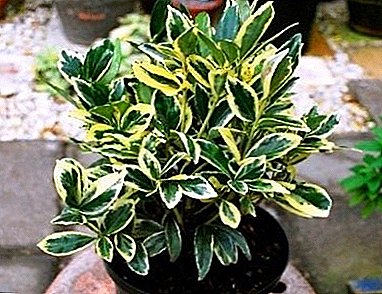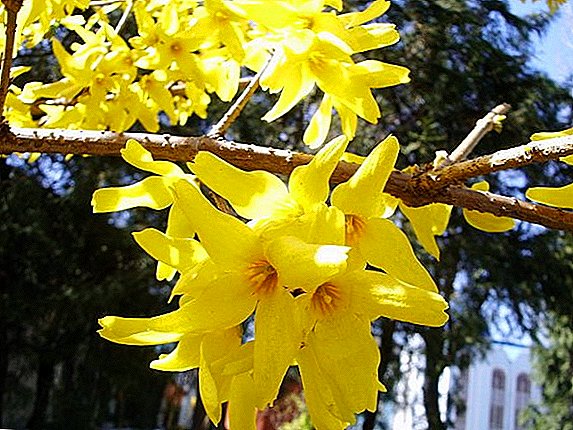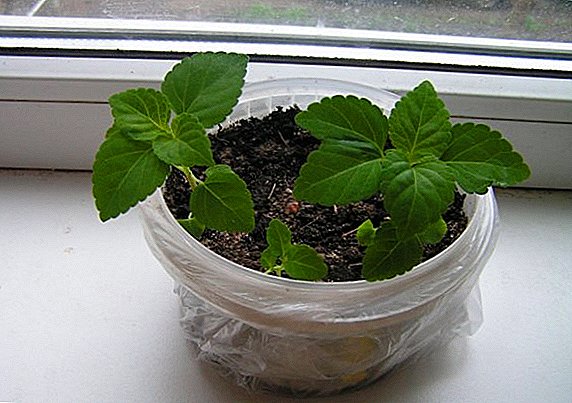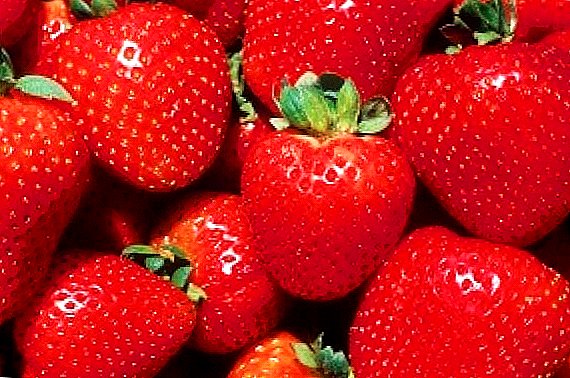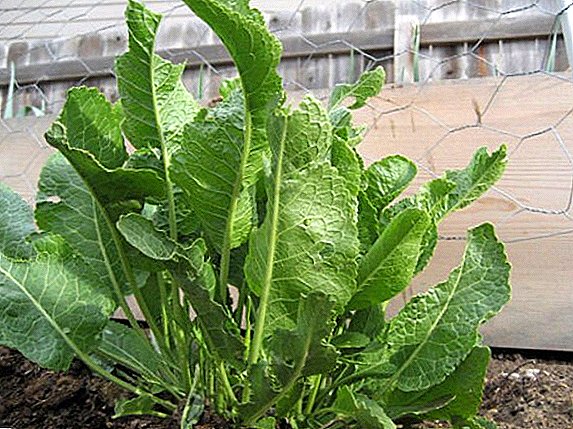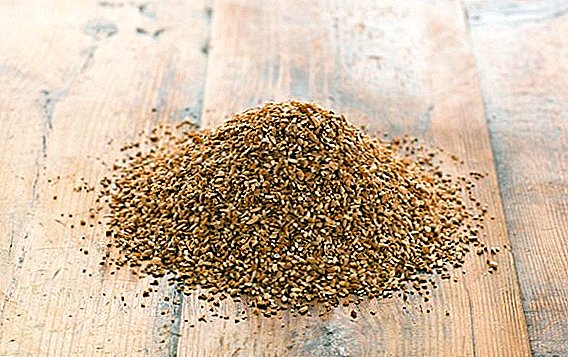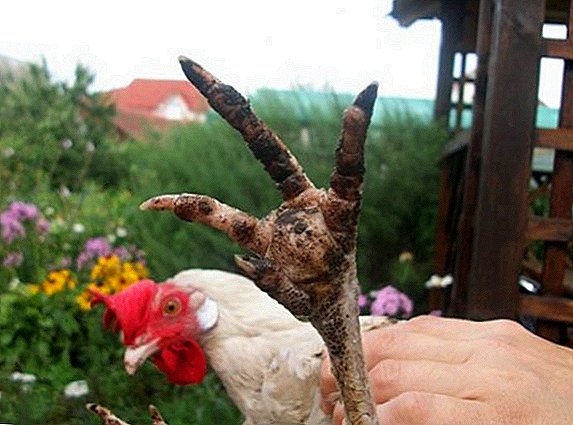 Among the many varieties of modern gardeners, those that are distinguished by original names seem especially interesting. So, for example, having heard about the Japanese Truffle tomatoes, you will probably want to familiarize yourself with their description and characteristics, which may later serve as a reason for their cultivation. In this article we will provide you with this opportunity and tell you about the appearance of unusual tomatoes, their varietal variations and cultivation agrotechnology.
Among the many varieties of modern gardeners, those that are distinguished by original names seem especially interesting. So, for example, having heard about the Japanese Truffle tomatoes, you will probably want to familiarize yourself with their description and characteristics, which may later serve as a reason for their cultivation. In this article we will provide you with this opportunity and tell you about the appearance of unusual tomatoes, their varietal variations and cultivation agrotechnology.
Appearance and description of the variety
This indeterminate variety (it does not have an end point of growth) is neither distinguished by high yields (only 2-4 kg of tomatoes from one bush), nor by the speed of fruit ripening (on average 110-120 days after planting), but at the same time, its unusual appearance fruits and good taste data could not leave it unnoticed by summer residents. Tomato shrubs "Japanese truffle" are quite high and, when cultivated in a greenhouse, often reach two meters in height. In open soil, these values are somewhat more modest and usually do not exceed 1.5 m. In any case, regardless of the specific place of growth, the lash will have to be tied up.  Variety "Japanese truffle" has several variations, the differences between them are expressed in the color of the fruit and taste characteristics. So, there are tomato bushes with red, black, orange, pink and even "golden" tomatoes. All fruits are pear-shaped and are characterized by light ribbing. The weight of such tomatoes reaches on average 100-200 g, and, basically, all of these varietal variations produce sweet, slightly acidic fruits, but with individual flavors. For example, due to the high sweetness of the fruits of the Japanese Golden Truffle, they are often eaten as ordinary fruits.
Variety "Japanese truffle" has several variations, the differences between them are expressed in the color of the fruit and taste characteristics. So, there are tomato bushes with red, black, orange, pink and even "golden" tomatoes. All fruits are pear-shaped and are characterized by light ribbing. The weight of such tomatoes reaches on average 100-200 g, and, basically, all of these varietal variations produce sweet, slightly acidic fruits, but with individual flavors. For example, due to the high sweetness of the fruits of the Japanese Golden Truffle, they are often eaten as ordinary fruits.
Important! Tomatoes of all varieties have dense skin and flesh, making them ideal for long-term transportation and storage.
Characteristic and variety varieties
“Japanese truffle” is still not very familiar to domestic gardeners, but thanks to such an exotic name, an increasing number of summer residents are interested in themselves. It was taken out in the open spaces of the Russian Federation and registered in 2000 as a hybrid variety, well suited for cultivation in open soil and in greenhouse conditions. Many housewives have already managed to appreciate its positive qualities, using for the preparation of canned food and other dishes.  The main advantages of the variety should also be attributed high disease resistance, and among the disadvantages of tomatoes it is impossible not to distinguish the unsuitability for the creation of tomato paste, excessive susceptibility to sharp temperature differences, insufficiently strong brushes and exactingness in terms of fertilizers.
The main advantages of the variety should also be attributed high disease resistance, and among the disadvantages of tomatoes it is impossible not to distinguish the unsuitability for the creation of tomato paste, excessive susceptibility to sharp temperature differences, insufficiently strong brushes and exactingness in terms of fertilizers.
For cultivation in open soil, only regions with a generally warm climate are suitable, while for cultivation in the middle lane it is necessary to plant seedlings of "Japanese truffles" in greenhouses, which have practically no effect on yield compared to the previous version. For cultivation in the northern areas of the pink variety is not suitable "Japanese truffles". After reviewing the general characteristics of the plant, it's time to pay attention to the peculiarities of its existing varieties.
"Japanese red truffle"
In this case, when growing a plant, you can count on picking fruits of a rich red color with a slight shade of brown. I must say that from an aesthetic point of view, such a combination in a certain way ennobles the fruit, introducing a certain zest to their appearance. The taste of red tomatoes "Japanese truffle" a little sweet, but give a characteristic sourness - great for blanks. 
Did you know? Tomato - a storehouse of nutrients (fiber, vitamins of group B, potassium, sodium, magnesium, phosphorus and other important elements), but most of the nutritional components found in dried fruit. For one kilogram you will have to process 8-14 kg of fresh crop.
"Japanese black truffle"
In fact, the fruits of this variety are not black, but dark brown, and in general taste characteristics or forms are no different from other variants. However, some gourmets say that the taste of black tomato "Japanese truffle" is more refined than that of other representatives, and it is because of this that they prefer it. 
"Japanese pink truffle"
 When characterizing this tomato, it is possible to distinguish only the sweeter taste and the pink color of the fruit, but otherwise it is similar to the previous tomatoes: it is just as dense and excellent for preservation.
When characterizing this tomato, it is possible to distinguish only the sweeter taste and the pink color of the fruit, but otherwise it is similar to the previous tomatoes: it is just as dense and excellent for preservation.
Nevertheless, some gardeners grow it as an ornamental plant on their site. Fruit weight ranges from 100-150 g.
"Japanese golden truffle"
This tomato can really be called unusual, because the color of its fruit is very different from the standard ideas about tomato. In addition to the rich yellow color, it has a beautiful golden hue. This varietal variety is very sweet in taste and resembles fruit in many ways. One meaty fruit weighs on average about 100-150 g. 
"Japanese orange truffle"
 Like the previous variety, this representative of tomatoes has a very unusual appearance, except that its color is even deeper, with a sunny orange shade.
Like the previous variety, this representative of tomatoes has a very unusual appearance, except that its color is even deeper, with a sunny orange shade.
Pear-shaped fruits in ripe form reach a mass of 150-250 g, although even if you remove them from the bushes ahead of time, there is nothing wrong with that, because the tomatoes will quietly “reach” on the windowsill.
Did you know? Tomatoes are approximately 95% water and, contrary to popular belief, any heat treatment does not reduce, but only improves their beneficial properties.
Agrotechnology
When growing the tomato variety "Japanese truffle", as in the case of the cultivation of other tomato varieties, the entire period from planting seeds to harvest can be divided into two parts: the care of the seedlings and the supervision of adult plants, and each stage has its own features
We advise you to familiarize yourself with the subtleties of growing tomato varieties: "Persimmon", "Mikado Pink", "Golden Heart", "Honey Drop", "Raspberry Miracle", "Raspberry Giant", "White Pouring", "Bare Bearded", "Black Prince "" Little Red Riding Hood "," Rapunzel ".
Sowing and growing seedlings
If the cultivation of the described varieties is planned in the open ground, then the sowing of seeds for seedlings is carried out already in March, so that at the end of May seedlings can be transplanted to a permanent place of their growth. With the further cultivation of "truffles" in the greenhouse, both of these periods are shifted a month ago.  The substrate for sowing seeds is prepared in advance and should consist of two parts of sod land, two parts of humus and one part of sifted sand. This soil will allow the seeds to quickly germinate and get the required amount of nutrients and trace elements. Seeds are immersed in the substrate to a depth of no more than two centimeters and sprinkled on top of a thin layer of soil.
The substrate for sowing seeds is prepared in advance and should consist of two parts of sod land, two parts of humus and one part of sifted sand. This soil will allow the seeds to quickly germinate and get the required amount of nutrients and trace elements. Seeds are immersed in the substrate to a depth of no more than two centimeters and sprinkled on top of a thin layer of soil.
Containers with seedlings should be kept in a warm room where the air temperature does not fall below +16 ° C. As soon as two real leaves appear on the seedlings, they are picked in separate containers. Approximately a week before the proposed planting in open soil, it is necessary to fertilize it with mineral compositions, the predominant components of which are potassium and phosphorus.
Important! The seedlings that emerge from the ground need to be periodically aired, raising the shelter, and as soon as the sprouts get a little stronger, they begin to be carried to the balcony for acclimatization.
Landing in the ground
Transplanting from the usual place in the boxes to the garden is always stressful for the seedlings, so you should carefully monitor its well-being under the open sky. Of course, it will be possible to land the seedlings on the street no sooner than the night frosts disappear. As for the soil temperature, the ideal conditions for the "Japanese truffle" would be +13 ° C at a depth of about 20 cm.  Before placing young bushes in prepared holes, be sure to inspect each of them and select only the most viable ones, setting aside specimens even with the slightest signs of disease.
Before placing young bushes in prepared holes, be sure to inspect each of them and select only the most viable ones, setting aside specimens even with the slightest signs of disease.
Tomato seedlings are planted in a well-lit area, following the scheme 40 × 40 cm. If you strictly follow all the rules, then the preparation of the beds should be done even in the autumn, as for the rapid and high-quality development of tomatoes at the time of planting in the ground should be a sufficient amount of nutrients.
Important! On the planted plants very young stepchildren (often merge with the trunk of a tomato), and so that they do not take away the nutrients from them, such processes must be promptly removed.
Care and watering
All varieties of tomatoes require regular but moderate introduction of fluid into the soil and, of course, the "Japanese truffle" is no exception in this regard. Watering needs to be done daily or every other day, in the evening, using only warm water separated by the sun for them. After irrigation, periodically loosening of the soil is carried out in order to prevent the formation of a crust on the surface, and at the same time we can weed a bed with plantings, removing weeds from it.  One of the features of tomato is the fast hall of growing branches, which is why, soon after transplanting, each bush must be tied to a support. If temperature jumps are characteristic of your region even at the end of spring, then you should additionally cover the plantings using straw, dry leaves, or even the remains of grain crops. Of course, in order not to risk and protect young saplings from diseases, instead of such mulch you can use special covering material.
One of the features of tomato is the fast hall of growing branches, which is why, soon after transplanting, each bush must be tied to a support. If temperature jumps are characteristic of your region even at the end of spring, then you should additionally cover the plantings using straw, dry leaves, or even the remains of grain crops. Of course, in order not to risk and protect young saplings from diseases, instead of such mulch you can use special covering material.
An important component of the care of the "Japanese truffle" is proper and timely feeding, and the application of mineral fertilizers can be done both under the root and foliar way, sprinkling the leaves and stems of tomatoes.
Read also about growing varieties of tomatoes: "Gina", "Rio Grande", "Katya", "Liana", "Maryina Roshcha", "De Barao", "Yamal", "Pink Paradise", "Verlioka", "Dubrava" , "Red is red", "Sanka", "Bull's heart", "Sugar bison".
Pests and diseases
According to the producers, the described variety should be highly resistant to pathogenic microorganisms and practically does not succumb to the development of fungal diseases, the most common of which is late blight.  According to the reviews of many gardeners, this is the case, and in this case the illness will not be able to destroy your plantings, although it is possible that tomatoes will be affected by another, equally unpleasant disease called fomoz. Therefore, as soon as you notice brown specks on the leaf plates with the black masses of the tiny bodies of the fungus contained in them, immediately remove them, and with them the affected fruits. The branches can be sprayed with the Hom fungicide. In addition, it will be useful to reduce the intensity of application of fertilizers with a high nitrogen content and slightly reduce irrigation.
According to the reviews of many gardeners, this is the case, and in this case the illness will not be able to destroy your plantings, although it is possible that tomatoes will be affected by another, equally unpleasant disease called fomoz. Therefore, as soon as you notice brown specks on the leaf plates with the black masses of the tiny bodies of the fungus contained in them, immediately remove them, and with them the affected fruits. The branches can be sprayed with the Hom fungicide. In addition, it will be useful to reduce the intensity of application of fertilizers with a high nitrogen content and slightly reduce irrigation.
Did you know? Translated from the ancient Greek language, the word "nitrogen" means "lifeless" - a logical name, given the fact that the substance does not have any odor, taste or color. The human body contains approximately 3% nitrogen.
Sometimes on tomatoes "Japanese truffle" there is a dry spot, which appears much earlier than fomosis and blight - almost immediately after transplanting plants into open soil. To determine the presence of the disease can be on dry round spots on the leaves of bushes, which in size can vary from a few millimeters to several centimeters. Sick leaf plates quickly dry and fall off. To cope with the disease, experts recommend using the drugs "Consento", "Antrakol" and "Tattu".  Among the pests of the “Japanese truffle” variety, thrips, spider mites and melon aphids, for the destruction of which Karbofos and Bison preparations are often used, may be of interest. To consolidate the positive effect of the use of fungicides by treating the leaves with soap and water.
Among the pests of the “Japanese truffle” variety, thrips, spider mites and melon aphids, for the destruction of which Karbofos and Bison preparations are often used, may be of interest. To consolidate the positive effect of the use of fungicides by treating the leaves with soap and water.
Conditions for maximum fructification
If you want to achieve maximum yield from your tomatoes, then special attention should be paid to preparing the soil for planting. As we mentioned earlier, the soil on the plot chosen for tomatoes begins to be processed from the autumn, making 1 m² approximately 1-3 kg of humus. To it will be useful to add one tablespoon of potash and two tablespoons of superphosphate.
Also, make sure that the substrate has a neutral acidity, for which wood ash is introduced into it. After the fertilizer, digging of the bed with a coup of the earth layer is carried out, and in order to preserve the nutritional value of the soil, large clods should be left on the surface (they will not allow the snow to penetrate into the lower layers and wash out useful trace elements from there).  When choosing a site for planting "Japanese Truffle" tomatoes, try to avoid places where solanaceous plants used to grow, and give preference to those on which the onions were grown.
When choosing a site for planting "Japanese Truffle" tomatoes, try to avoid places where solanaceous plants used to grow, and give preference to those on which the onions were grown.
And, of course, to obtain a bountiful harvest, plants will need good care in compliance with all the requirements for watering, removing stepsons and fertilizing.
Tomatoes "Japanese truffle" deserve your attention not only because they have an unusual appearance, but also because of their good taste and pickyness in the care. All this suggests that in the near future the variety will become even more popular among domestic summer residents.



